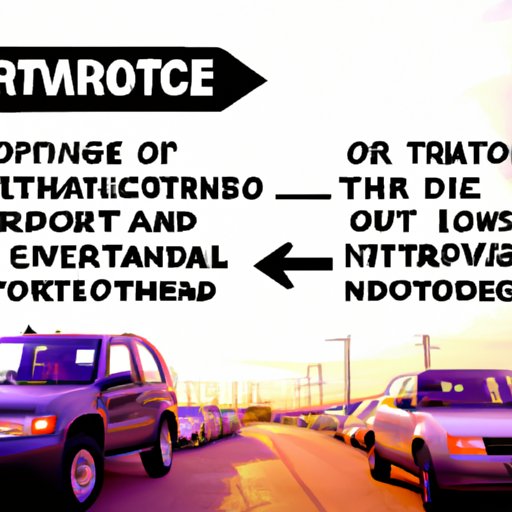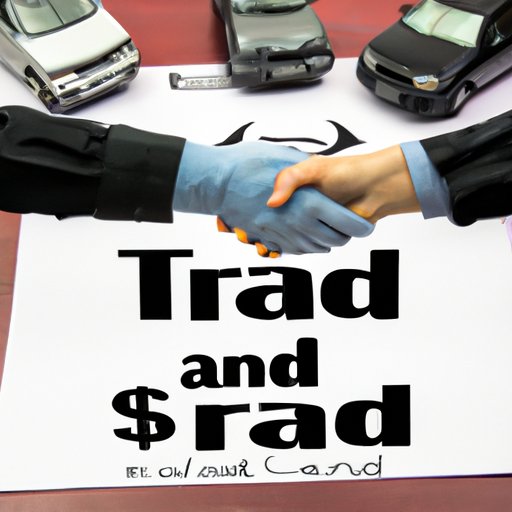Introduction
Trading in your car is a convenient way to upgrade to a new vehicle without having to worry about selling your old one. But if you’ve never done it before, it can be hard to understand exactly how the process works. This article will provide an overview of how a trade in works, including step-by-step instructions and helpful tips.
Definition of Trade In
A trade in is when you exchange your old vehicle for a new one at a dealership. The dealership will offer you a certain amount of money (known as the “trade-in value”) for your old car, which can then be used toward the purchase of a new vehicle. This is usually more convenient than trying to sell your car privately, since it eliminates the hassle of finding a buyer and negotiating a price.
Basic Overview of the Process
The trade in process typically involves three steps: determining the trade-in value of your vehicle, negotiating the best price for your trade-in, and finalizing the deal. Here’s a brief overview of each step:
- Determining the Trade-In Value of Your Vehicle: This involves researching the value of your car and gathering the necessary documents, such as the title and registration.
- Negotiating the Best Price for Your Trade-In: This involves working with the dealership to negotiate the best possible price for your vehicle.
- Finalizing the Trade-In Deal: This involves signing the paperwork and transferring ownership of the vehicle to the dealership.
Step-by-Step Guide to Understanding How a Trade In Works
Now that you have a basic understanding of the process, let’s look at each step in more detail.
Determining the Trade-In Value of Your Vehicle
Before trading in your vehicle, it’s important to research its trade-in value. This will help you determine how much money you can expect to receive from the dealership. To do this, you can use online resources such as Kelley Blue Book or Edmunds.com. These websites allow you to enter information about your vehicle, such as make, model, year, and mileage, and they will generate an estimated trade-in value. It’s also important to gather all of the necessary documents, such as the title and registration, so that you can prove ownership of the vehicle.
Negotiating the Best Price for Your Trade-In
Once you know the estimated trade-in value of your vehicle, it’s time to start negotiating with the dealership. You should always be prepared to haggle and try to get the best possible price for your vehicle. It’s important to keep in mind that the dealership won’t offer you the full trade-in value of your vehicle; they need to make a profit in order to stay in business. However, if you’re willing to negotiate, you may be able to get a better price.
Finalizing the Trade-In Deal
Once you have agreed on a price for your trade-in, it’s time to finalize the deal. This involves signing the paperwork and transferring ownership of the vehicle to the dealership. Be sure to read all of the paperwork carefully before signing and ask any questions if something doesn’t make sense. Once the paperwork is complete, you will receive the agreed-upon amount in cash or as a credit toward the purchase of your new vehicle.

Exploring the Benefits of Trading in Your Vehicle
Trading in your vehicle has many advantages over selling it privately. Here are a few of the benefits:
Saving Time and Effort
One of the biggest advantages of trading in your vehicle is that it saves you time and effort. Selling a car privately can be a long and tedious process, but trading it in is quick and easy. All you have to do is bring your vehicle to the dealership and sign the paperwork.
Avoiding the Hassle of Selling Privately
Selling a car privately can be difficult, especially if you don’t have a lot of experience. You have to advertise the vehicle, show it to potential buyers, and negotiate a price. Trading in your vehicle eliminates all of this hassle, since you only have to deal with one person—the dealership representative.
Receiving an Immediate Cash Payment
When you trade in your vehicle, you will receive an immediate cash payment or credit toward the purchase of your new vehicle. This is much faster and more convenient than waiting for a private sale to go through. Plus, you don’t have to worry about dealing with checks or other payment methods.

What You Need to Know About Trading In Your Car
Before trading in your vehicle, there are a few things you should know. Here are a few key tips:
Researching Your Vehicle’s Trade-In Value
As mentioned above, it’s important to research the trade-in value of your vehicle before trading it in. This will give you a good idea of what you can expect to receive from the dealership. Additionally, you should check to see if the dealership offers special promotions or deals that could increase the value of your trade-in.
Gathering the Necessary Documents
Be sure to gather all of the necessary documents, such as the title and registration, before trading in your vehicle. This will help prove that you are the rightful owner of the vehicle and will make the process go more smoothly.
Preparing Your Vehicle for Trade-In
It’s also important to prepare your vehicle for trade-in. This includes cleaning the interior and exterior of the vehicle and making any necessary repairs. This will help make your vehicle more attractive to potential buyers and could potentially increase the value of your trade-in.

Tips for Getting the Most Out of a Trade In
Here are a few additional tips for getting the most out of a trade in:
Shop Around for the Best Deal
Don’t be afraid to shop around for the best deal. Different dealerships may offer different prices for your vehicle, so it pays to take the time to compare offers. Additionally, some dealerships may offer additional incentives, such as discounts or free services, that can make the deal even sweeter.
Have a Backup Plan If the Deal Falls Through
It’s always a good idea to have a backup plan in case the deal falls through. Have a list of potential buyers ready just in case the dealership isn’t interested in purchasing your vehicle.
Take Advantage of Special Offers
Finally, be sure to take advantage of any special offers or promotions that the dealership may be offering. These can often increase the value of your trade-in, so it pays to ask about them.
Common Questions and Answers About Trading In Your Vehicle
Here are some of the most common questions people have about trading in their vehicles:
What Is the Difference Between a Trade-In and a Private Sale?
A trade in is when you exchange your old vehicle for a new one at a dealership. A private sale is when you sell your vehicle directly to a private buyer. The main difference is that with a trade in, you receive an immediate cash payment or credit toward the purchase of a new vehicle. With a private sale, you have to wait for the buyer to pay you.
Does It Make Sense to Trade In a Vehicle with High Mileage?
It depends. Generally speaking, vehicles with high mileage are worth less than those with low mileage. However, some dealerships may be willing to offer more for a vehicle with higher mileage if it has been well maintained. It’s always a good idea to research the trade-in value of your vehicle before trading it in.
What Should I Do If I Am Unhappy With My Trade-In Offer?
If you are unhappy with the offer you receive from the dealership, you can always try to negotiate a better price. Additionally, it may be worth shopping around to see if other dealerships are offering a better deal. Finally, you can always opt to sell your vehicle privately instead of trading it in.
Conclusion
Trading in your vehicle is a great way to get an immediate cash payment for your car. By following this guide, you can learn how the process works and get tips for getting the best deal. Remember to research your vehicle’s trade-in value, gather the necessary documents, and negotiate the best possible price for your vehicle.
(Note: Is this article not meeting your expectations? Do you have knowledge or insights to share? Unlock new opportunities and expand your reach by joining our authors team. Click Registration to join us and share your expertise with our readers.)
